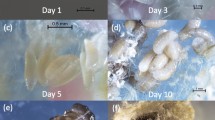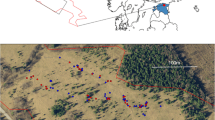Abstract
Field surveys at five sites within desert locust breeding habitats around Port Sudan during three successive seasons indicated that early in the rainy season the incoming solitary females oviposited predominantly in the vicinity of Heliotropium spp. (∼66%) and millet (∼32%) seedlings. Solitary nymphs also preferred to feed on these plants. Follow-up cage experiments were conducted in the field in which solitary and gregarious female locusts were presented with choices of selected desert plants and egg pods. When presented with bulrush millet, Heliotropium spp., Zygophyllum simplex, and untreated moistened sand, solitary females oviposited adjacent to the first two plants (40% and 60%, respectively). However, when offered a choice of either or both of these plants together with egg pods derived from gregarious and/or solitary insects, solitary females showed a significantly higher preference for ovipositing near gregaria egg pods than near the plants, with solitaria egg pods eliciting the least response. In contrast with solitary females and in the absence of gregaria egg pods, gregarious females preferred to oviposit in untreated moist (control) sand (74–77%) away from the plants (6–14%) or solitaria egg pods (∼4%). However, when present, gregaria egg pods elicited significantly more oviposition. These and previous results indicate a hierarchy of phase-dependent oviposition preferences in the desert locust and are interpreted in terms of a strong propensity of the species to exploit opportunities under appropriate conditions to facilitate congregation and the gregarization of the progeny.
Similar content being viewed by others
REFERENCES
Bouaichi, A., Roessingh, P., and Simpson, S. J. 1995. Analysis of the behavioural effects of crowding and re-isolation on solitary-reared adult desert locusts (Schistocerca gregaria) and their offspring. Physiol. Entomol. 20:199–208.
Bouaichi, A., Simpson, S. J., and Roessingh, P. 1996. The influence of environmental microstructure on the behavioural phase state and distribution of the desert locust Schistocerca gregaria. Physiol. Entomol. 21:247–256.
Deng, A. L., Torto, B., Hassanali, A., and Ali, E. E. 1996. Effects of shifting to crowded or solitary conditions on pheromone release and morphometrics of the desert locust, Schistocerca gregaria (Forskål) (Orthoptera: Acrididae). J. Insect Physiol. 42:771–776.
Ghaout, S., Louveaux, A., Mainguet, A. M., Deschamps, M., and Rahal, Y. 1991. What defense does Schouwia purpurea (cruciferae) have against the desert locust? J. Chem. Ecol. 17:1499–1515.
Hassan, H. M. 1974. An illustrated guide to the plants of Erkowit. Herbarium publication 1. Printing House, University of Khartoum, 104 pp.
Hemming, C. F., and Symmons, P. M. 1969. The germination of Schouwia purpurea (Forsk.) Shweinf, and its role as a habitat of the desert locust. Anti-Locust Bull. 46:1–38.
Islam, M. S., Roessingh, P., Simpson, S. J., and McCaffery, A. R. 1994a. Parental effects on the behaviour and colouration of nymphs of the desert locust Schistocerca gregaria. J. Insect Physiol. 40:173–181.
Islam, M. S., Roessingh, P., Simpson, S. J., and McCaffery, A. R. 1994b. Effects of population density experienced by parents during mating and oviposition on the phase of hatching desert locusts, Schistocerca gregaria. Proc. R. Soc. B 257:93–98.
Kennedy, J. S. 1939. The behaviour of the desert locust, Schistocerca gregaria (Forskål) (Orthoptera) in an outbreak centre. Trans. R. Entomol. Soc. 89:385–452.
McCaffery, A. R., Simpson, S. J., Saiful, Islam, M., and Roessing, P. 1998. A gregarising factor present in the egg pod foam of the desert locust Schistocerca gregaria. J. Exp. Biol. 201:347–363.
Njagi, P. G. N., Torto, B., Obeng-Ofori, D., and Hassanali, A. 1996. Phase-independent reponses to phase-specific aggregation pheromone in adult desert locust, Schistocerca gregaria (Forskål) (Orthoptera: Acrididae). Physiol. Entomol. 21:131–137.
Norris, M. J. 1963. Laboratory experiments on gregarious behaviour in ovipositing females of the desert locust, (Schistocerca gregaria [Forskål]). Entomol. Exp. Appl. 6:279–303.
Norris, M. J. 1968. Laboratory experiments on oviposition responses of the desert locust, Schistocerca gregaria (Forskål). Anti-Locust Bull. 43:1–47.
Norris, M. J. 1970. Aggregation response in ovipositing females of the desert locust, with special reference to the chemical factor. J. Insect Physiol. 16:1493–1515.
Ochieng-Odero, J. P. R., Ndugo, S. M., El Bashir, S., and Capstick, P. B. 1994. A method of rearing crowded (gregarious) and isolated (solitary) locusts (Orthoptera: Acridiae) in the laboratory, pp. 33–44, in P. G. N. Njagi and M. F. B. Chaudhury (eds.).
Pener, M. P. 1991. Locust phase polymorphism and its endocrine relations. Adv. Insect Physiol. 23:1–79.
Popov, G. B. 1958. Ecological studies on oviposition by swarms of the desert locust (Schistocerca gregaria Forskål) in eastern Africa. Anti-Locust Bull. 31:1–70.
Rai, M. M., Hassanali, A., Saini, R. K., Odongo, H., and Kahoro, H. 1997. Identification of components of the oviposition aggregation pheromone of the gregarious desert locust Schistocerca gregaria. J. Insect Physiol. 43:83–97.
Rainey, R. C. 1962. Some effects of environmental factors on movements and phase-change of locust populations in the field. Physiologie comportement et écologie des acridiens en rapport avec la phase. C.N.R.S., Paris, pp. 175–199.
Roessingh, P., and Simpson, S. J. 1994. The time-course of behavioural phase change in nymphs of the desert locust Schistocerca gregaria. Physiol. Entomol. 19:191–197.
Roffey, J., and Popov, G. 1968. Environmental and behavioural processes in a desert locust outbreak. Nature 219:446–450.
Saini, R. K., Rai, M. M., Hassanali, A., Wawiye, J., and Odongo, H. 1995. Semiochemicals DESERT LOCUST OVIPOSITION from froth of egg pods attract ovipositing female Schistocerca gregaria. J. Insect Physiol. 41:711–716.
Steedman, A. (ed.). 1998. Locust Handbook, 2nd ed. Overseas Development Natural Resource Institute, London, 180 pp.
Stower, W. J., Popov, G. B., and Greathead, D. J. 1958. Oviposition behaviour and egg mortality of the desert locust (Schistocerca gregaria Forskål) on the coast of Eritrea. Anti-Locust Bull. 30:1–331.
Torto, B., Obeng-Ofori, D., Njagi, P. G. N., Hassanali, A., and Amiani, H. 1994. Aggregation pheromone system of adult gregarious desert locust, Schistocerca gregaria (Forskål) (Orthoptera: Acrididae). J. Chem. Ecol. 20:1749–1762.
Torto, B., Njagi, P. G. N., Hassanali, A., and Amiani, H. 1996. Aggregation pheromone system of nymphal gregarious desert locust, Schistocerca gregaria (Forskål) (Orthoptera: Acrididae).J. Chem. Ecol. 22:2273–2281.
Torto, B., Assad, Y. O. H., Njagi, P. G. N., Hassanali, A. 1999. Evidence for additional pheromonal components mediating oviposition aggregation in Schistocerca gergaria. J. Chem. Ecol. 25:835–845.
Uvarov, B. P. 1921. A revision of the genus Locusta L. (Pacytylus L. Fieb.), with a new theory as to the periodicity and migrations of locusts. Bull. Entomol. Res. 12:135–163.
Uvarov, B. P. 1966. Grasshoppers and Locusts, Vol. 1. Cambridge University Press, London, 481 pp.
Uvarov, B. P. 1977. Grasshoppers and Locusts, Vol. 2. Centre for Overseas Pest Research, London, 613 pp.
Wilcoxon, F. 1945. Individual comparisons by ranking methods. Biomet. Bull. 1:80–83.
Woodrow, D. F. 1965. Observations on the red locust (Nomadacris septemfasciata Serv.) in the Rukwa Valley, Tanganyika, during its breeding season. J. Anim. Ecol. 34:187–200.
Author information
Authors and Affiliations
Rights and permissions
About this article
Cite this article
Bashir, M.O., Hassanali, A., Rai, M.M. et al. Changing Oviposition Preferences of the Desert Locust, Schistocerca gregaria, Suggest a Strong Species Predisposition for Gregarization. J Chem Ecol 26, 1721–1733 (2000). https://doi.org/10.1023/A:1005599115497
Issue Date:
DOI: https://doi.org/10.1023/A:1005599115497




